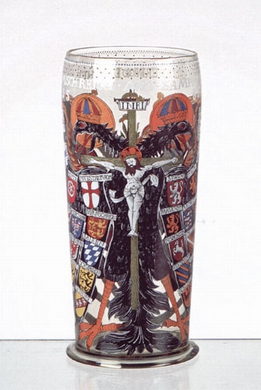 |
UAO4 -
Welcoming Rummer with the symbol of the unity of Holy Roman Empire
The motive of an eagle with two heads originate in 395 A.D. when, after the death of the Emperor Theodosius, the splitting of the Roman Empire took place. The Empire was divided into the Western and Eastern part between his two sons Arcadius and Honorius. From that moment on the two-headed eagle becomes an official emblem of the Roman Empire. Oldest preserved painting comes from an essay "De Imperio Romano" written by Peter von Andlau in 1460. This was a very popular pattern, widely used for next 150 years.
There is an aureole surrounding the heads of the eagle, on the chest stands holy rood, on the wings, assorted according to the precise order, are the coats of arms of the Kurfürsts (electors of an Emperor) and territorial parts of an Empire. Over the eagle an inscription : "DAS HEILIG RÖMISCH REICH MIT SAMPT SEINEN GLIEDERN 1585". On the opposite side between the wings blue snake twining around the cane (sign of the holy-cross of the Old Testament). Very popular with the nobility at that time.
Enamel painting made in bright colours, painted on the historic forest-glass replica, very careful workmanship, about two weeks of work, high-tone centrepiece of every collection of glass. Recommended to collectors and museums. Originals to be seen in UPM Prague and Victoria and Albert Museum, London.
Altura : 30 cm / 12 inches |
|
|